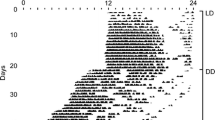Summary
Wheel-running activity was recorded in male golden hamsters (Mesocricetus auratus) kept in constant dim illumination. For periods of several weeks the lights in the cabinet were turned off daily at the same time of day, either for 1 h or 2 h. Despite these periodically recurring dark pulses, the circadian activity rhythms continued to free-run, and consequently crossed through the pulses at a more or less regular speed. During a dark pulse, the activity was usually enhanced. The amount of these masking effects varied with the phase of the circadian cycle at which the pulse occurred. The responses were maximal a few hours after the onset of spontaneous activity, and minimal during the rest-time of the animal.
Similar content being viewed by others
References
Aschoff J (1960) Exogenous and endogenous components in circadian rhythms. Cold Spring Harbor Symp Quant Biol 25:11–28
Aschoff J (1966) Circadian activity patterns with two peaks. Ecology 47:657–662
Aschoff J, von Goetz C (in press) Masking and circadian activity rhythms in canaries by light and dark. J Biol Rhythms
Binkley S, Mosher K (1985) Direct and circadian control of sparrow behavior by light and dark. Physiol Behav 35:785–797
Boulos Z, Morin LP (1985) Entrainment of split circadian activity rhythms in hamsters. J Biol Rhythms 1:1–15
Boulos Z, Rusak B (1982) Circadian phase response curves for dark pulses in the hamster. J Comp Physiol 146:411–417
Elliott JA (1976) Circadian rhythms and photoperiodic time measurements in mammals. Fed Proc 35:2339–2346
Ellis GB, McKlveen RE, Turek FW (1982) Dark pulses affect the circadian rhythm of activity in hamsters kept in constant light. Am J Physiol 242:R44-R50
Eriksson L-O (1978) Nocturnalism versus diurnalism — dualism within fish individuals. In: Thorpe JE (ed) Rhythmic activity of fishes. Academic, New York, pp 69–89
Gander PH, Moore-Ede MC (1983) Light-dark masking of circadian temperature and activity rhythms in squirrel monkeys. Am J Physiol 245:R927-R934
Lamprecht G, Weber F (1973) Mitnahme, Frequenzmultiplikation und Maskierung der LaufaktivitÄt von Carabus-Arten (Coleoptera) durch Lichtzyklen. J Insect Physiol 19:1579–1590
Moline ML, Albers HE, Todd RB, Moore-Ede MC (1981) Light-dark entrainment of proestrous LH surges and circadian locomotor activity in female hamsters. Horm Behav 15:451–458
Pittendrigh CS (1974) Circadian oscillations in cells and the circadian organization of multicellular system. In: Schmidt FO, Warren FG (eds) The neurosciences: third study program. MIT Press, Cambridge, pp 437–458
Author information
Authors and Affiliations
Rights and permissions
About this article
Cite this article
Aschoff, J., von Goetz, C. Masking of circadian activity rhythms in hamsters by darkness. J. Comp. Physiol. 162, 559–562 (1988). https://doi.org/10.1007/BF00612521
Accepted:
Issue Date:
DOI: https://doi.org/10.1007/BF00612521




